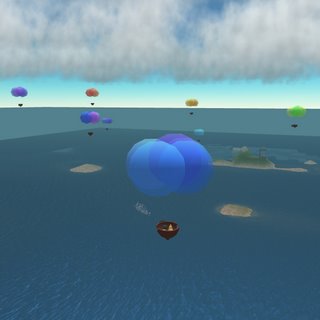Second Life Blimps Set Course For Virtual Evolution
 A Second Lifer has been blogging recently about his development of wandering hot-air balloons which anyone can hop into and ride around in but cannot be controlled. These "blimps" cross property lines in SL and, when unoccupied, are often destroyed by frustrated leaseholders who consider them a form of pollution. (The virtual world allows for teleportation from and to any point, which makes the very idea of physics-dependent travel a kind of liberation theology.) But now the blimps' creator is turning blind watchmaker, and things are getting pretty interesting: he's setting up his blimps to evolve based on their ability to survive in the existing hostile environment.
A Second Lifer has been blogging recently about his development of wandering hot-air balloons which anyone can hop into and ride around in but cannot be controlled. These "blimps" cross property lines in SL and, when unoccupied, are often destroyed by frustrated leaseholders who consider them a form of pollution. (The virtual world allows for teleportation from and to any point, which makes the very idea of physics-dependent travel a kind of liberation theology.) But now the blimps' creator is turning blind watchmaker, and things are getting pretty interesting: he's setting up his blimps to evolve based on their ability to survive in the existing hostile environment.
As of today, each blimp has its own genetic material. each gene codes some behavior of the blimp. one gene specifies the color of the balloons. another gene (set) specifies position in the flock. yet more code for sinusoidal variations in position (a Fourier series, as Seifert points out.)The blimps' creator pointed back to a fascinating study of virtual evolution back in 1994 by Karl Sims, who now runs the animation studio GenArt. Sims deployed box-shaped "organisms" in a virtual space, set up a mechanism for random mutations to generate increasingly complex organisms, and wrote computer programs to edit them out of existence at predetermined intervals based on various criteria (swimming ability, speed of locomotion on land, and ultimately, the ability to capture a ball from a similarly-evolved opponent in a tournament setting).blimps who (by chance) wander into dangerous areas will die, and their genes will disappear from the gene pool. blimps who (by chance) avoid danger will reproduce more often, and their genes will dominate the gene pool.
 Evolution trials led to an astonishing variety of locomotion and competitive techniques, and you can watch a video of clips of these evolved "virtual organisms" at the Internet Archive.
Evolution trials led to an astonishing variety of locomotion and competitive techniques, and you can watch a video of clips of these evolved "virtual organisms" at the Internet Archive.







No comments:
Post a Comment